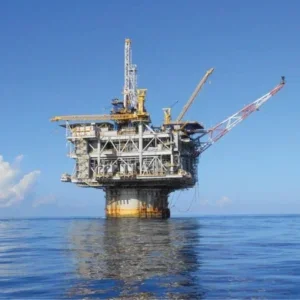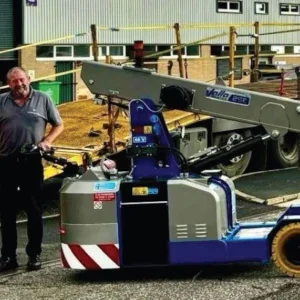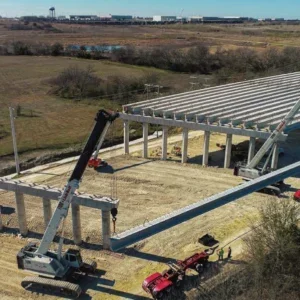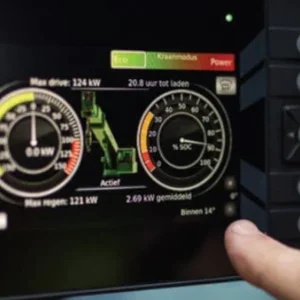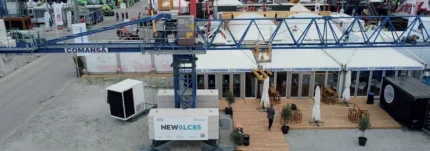
One of the most eye-catching tower crane stands at Bauma 2025 belonged to manufacturer Wolffkran; the bright red liveries of multiple Wolff tower cranes popped against Munich’s blue-sky.
On the Wolffkran stand the atmosphere was bright, too. Since Bauma 2022 the company has further expanded into the Kingdom of Saudi Arabia (KSA).
It has been selling cranes there since 2009 but has now established a full rental and service business. It has also started manufacturing cranes there, too.
Complimenting this expanded presence Wolffkran’s CEO, Duncan Salt, revealed a significant KSA crane contract: starting in May 2025 Wolffkran will provide cranes for the Salman Stadium site – a huge football and entertainment facility in Riyadh.
BIG BOYS
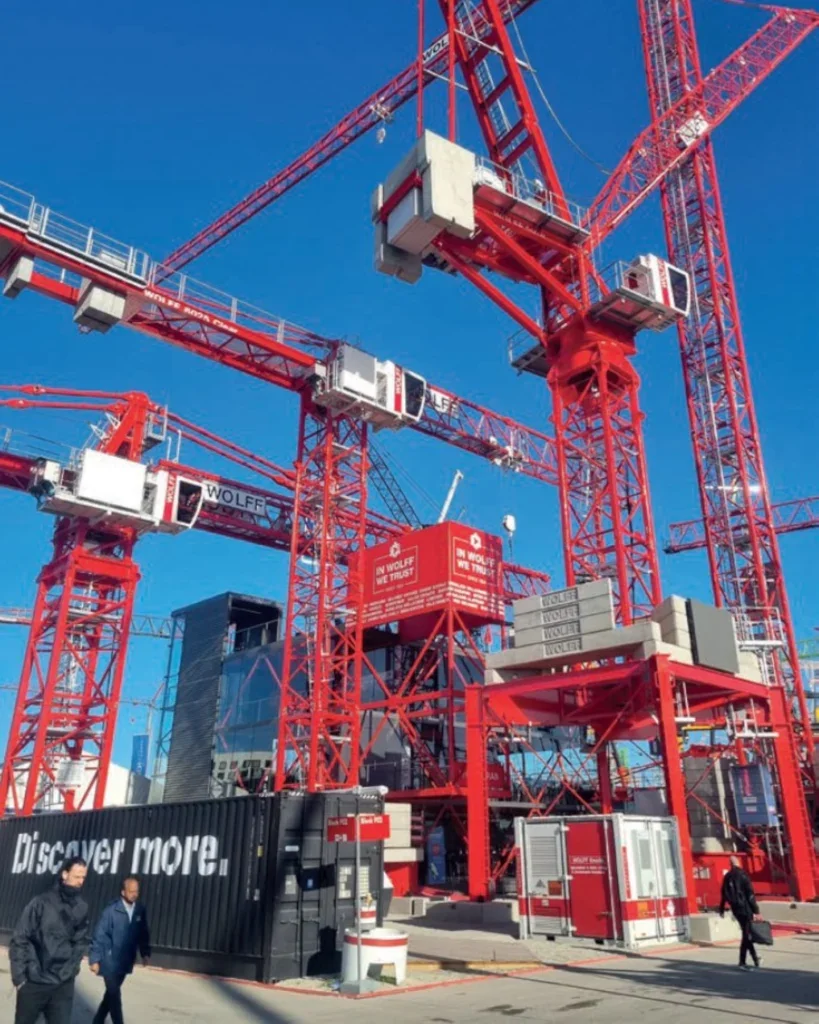
On Wolffkran’s stand there were multiple new tower cranes, all at the large end of the spectrum. The largest crane on the stand, making its debut at Bauma, was the 8095 Compact – the first Wolff trolley jib crane in the 900mt class.
The crane’s compact nature is manifest in the tower top section which is about six metres shorter than the cross-jib version.
It comes with an automatically couplable double trolley and is available in two variants: the twofall model Wolff 8095.25, with a maximum lifting capacity of 25 tonnes and a tip load capacity of 10.5t (with Wolff Boost at an 80m jib length); and the convertible two- and four-fall model Wolff 8095.40, with a double, automatically couplable, and separable trolley and a maximum lifting capacity of 40t. A 110kW hoist winch provides operating speeds of up to 160m/min.
The jib length can be flexibly adjusted in five-metre increments between 30 and 80m.
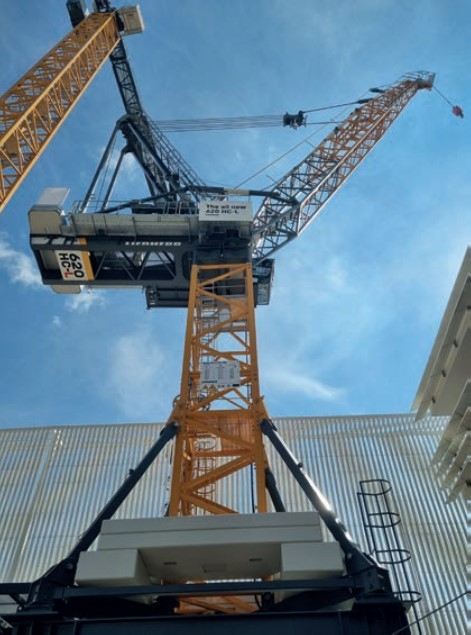
The crane has a tower connection for 2.90 x 2.90m TV 29 tower elements which, when combined with the next larger Wolff tower element (TV 33), enables freestanding tower heights of up to 100m.
Another debut on Wolffkran’s stand was the Wolff 8038 Clear – a new 560tm class flat-top tower crane, the largest flat-top in Wolffkran’s portfolio to date.
It has a 20t maximum lifting capacity and can lift 3.8t at the maximum jib length of 80m (4.2t with Wolff Boost). An optional extension can increase the jib length to 85m, where it can still lift 2.1t at the tip.

Its optimised patented jib design reduces assembly weight. A toolfree plug connection on the top chord, bolt depots for overhead installations, and additional platforms for divided jib assembly are designed to make setup easier.
Wolffkran has also revised the design of the lower chord construction to save around ten percent in material costs and reduced assembly weights.
As a pure two-line crane, the Wolff 8038 Clear can be ordered with either a 75 kW or a 110 kW hoist winch, enabling operating speeds of up to 132 m/min or 190 m/min respectively.
A US-version with a 110 kW hoist winch is also available.
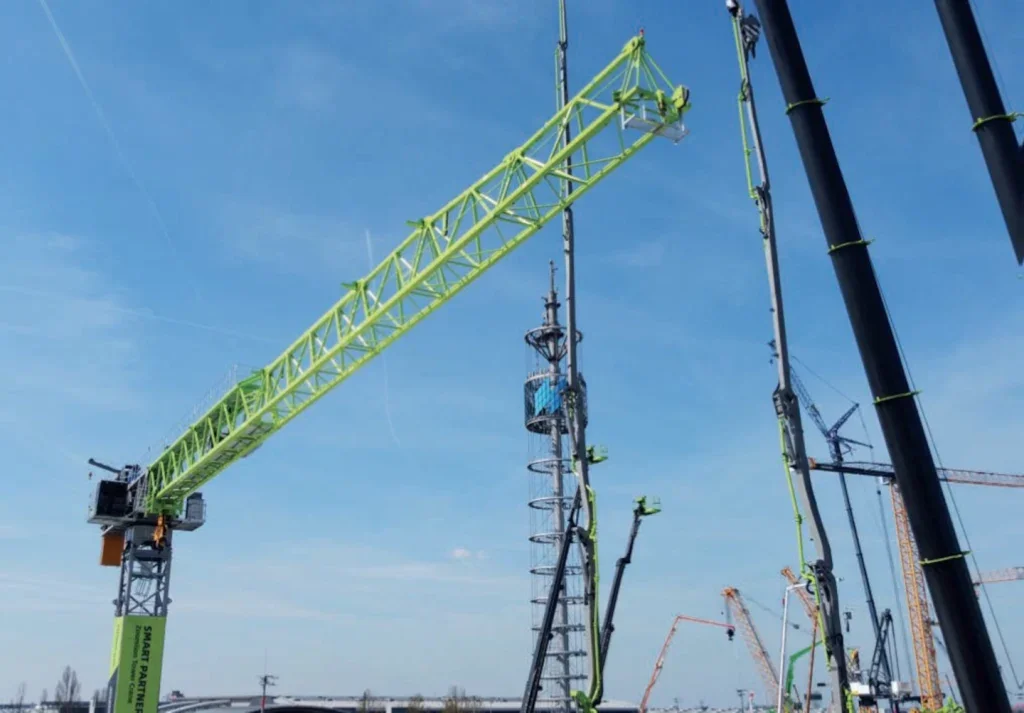
The crane is equipped as standard with a 2.3-metre tower connection but can also be mounted on a 2.0-metre tower to fit into elevator shafts. It can be transported on six trucks.
Also on the Wolff stand was the new Wolff 7021 Clear, a flat-top in the 224mt class. It is the evolution of the Wolff 7021 FX prototype shown at Bauma 2022.
It is available in two versions: the Wolff 7021.8 Clear with a lifting capacity of 8.5t, and the Wolff 7021.10 Clear with a lifting capacity of 10.5t. A third 12.5t version is in development.
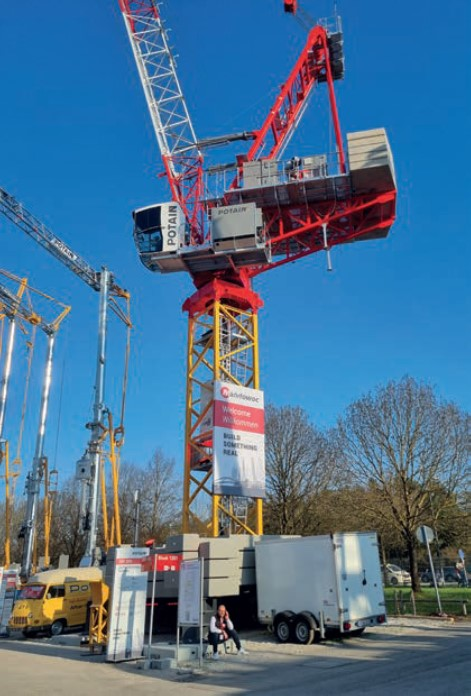
The crane has a tip load capacity of 2.1t (2.3t with Wolff Boost) at 70m of jib. The jib can be extended between 25 and 70m in 2.5m increments.
The Wolff 7021 Clear is equipped with two slewing gears and, depending on the version, is available with 45kW (8.5 and 10.5t) or 67kW hoisting gear (12.5t), achieving a working speed of up to 94m per minute.
The crane is primarily aimed at the European market and can be transported on three trucks.
To improve assembly and accessibility the ballast frame with the hoist winch can be assembled /disassembled on the stationary crane rather than on the ground via a quick connection system.
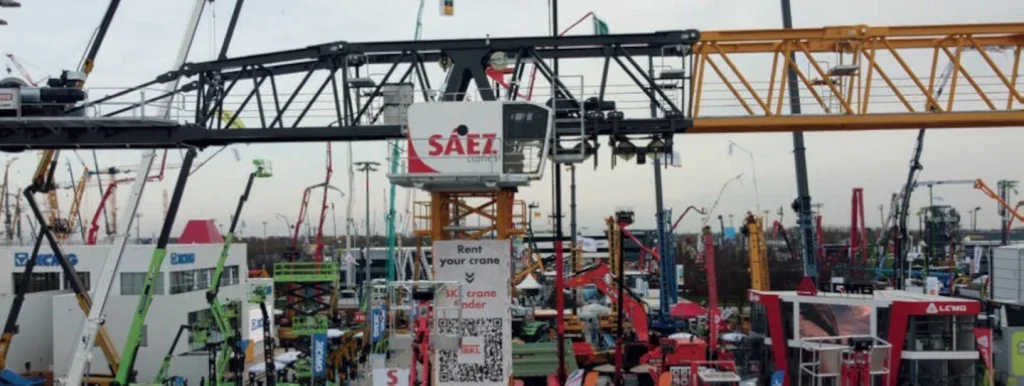
Another new Wolffkran crane was the Wolff 550 B luffer which fills the gap between Wolffkran’s 355 B and 630 B. Initially, the 550 B will be launched with a 110-kW hoist winch, enabling a maximum lifting capacity of 30 tonnes in two-fall operation and 15 tonnes in single-fall mode. At the tip of its maximum 65-metre jib, it can lift five tonnes.
By the end of the year Wolffkran plans to offer the 550 B with a more powerful hoist winch enabling it to lift up to 36 in two-fall operation. Additionally, there will be a US version with a 132-kW hoist winch.
The Wolff 550 B has a hook path of 920m (single-fall) or 460m (two-fall) and a lifting speed of up to 200m per minute. It comes as standard with a 2.3m tower connection, allowing freestanding heights of nearly 52m. When mounted on a 2.9m tower, it can reach up to 82.2m without additional support.
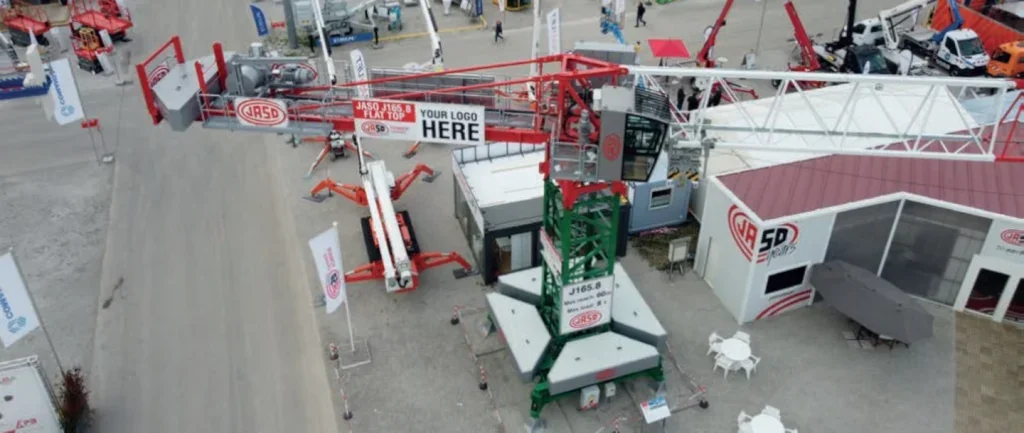
The luffer is available for order starting in June and should be launched in Europe, the US, and the Middle East later this year
LIEBHERR
Another spectacular stand at Bauma belonged to manufacturer Liebherr. The stand was the biggest at the show and multiple tower cranes were on display.
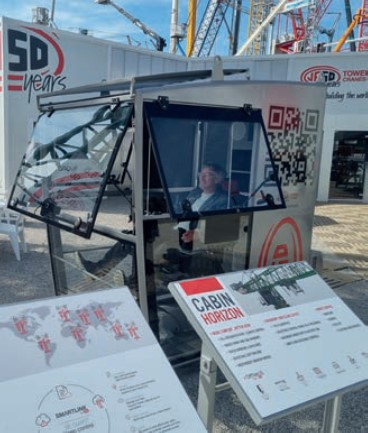
Representing Liebherr’s luffers was the 620 HC-L; Liebherr used Bauma to mark a major update to its HC-L series with the new 440 HC-L 12/24, 440 HC-L 18/36, and 620 HC-L 18/36. The cranes offer increased performance and reduced out of service positions.
The 440 HC-L is available in two lifting capacity versions: the 440 HC-L 12/24 and the 440 HC-L 18/36. Its bigger brother, the 620 HC-L, is equipped to tackle large scale construction projects with its 18/36 tonne lifting capacity.
Both models offer fast load handling in one-fall operation, says Liebherr. This has a positive impact on construction time for building heights of 100m and higher.
Quick re-reeving for two-fall operation also facilitates the lifting of heavy components.
Load-Plus means lifting capacity can be increased for specific load charts. The 440 HC-L offers an increase in jib head lifting capacity of up to 1.65t (52 percent), while the 620 HC-L achieves an increase of up to 3.25t (76 percent).
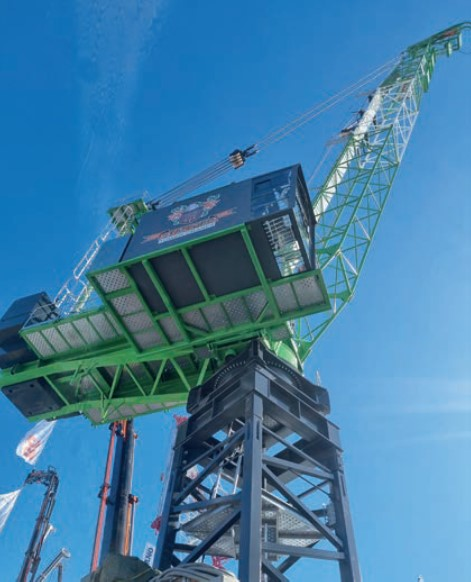
Pre-assembled assemblies reduce the time needed for setting up on site. The hoist and adjusting ropes come already mounted on the drum and the counter-ballast consists of one ballast block.
A central switchgear cabinet, mechanical quick connections, and a small number of transport units help speed up assembly.
FIBRE ROPE
The crane series is the first to make use of aramid guying for luffing jib cranes.
The lightweight material reduces weight on the jib, which increases lifting capacity as weight is saved compared to steel rope.
Liebherr also had two EC-B flat-tops erected on its stand: the 520 EC-B 20 Fibre and the 240 EC-B 10 Fibre. These were also showcasing Liebherr’s latest fibre rope developments.
Liebherr says its fibre rope cranes are becoming increasingly popular around the globe. Set to boost this popularity is Liebherr’s new rope shortening option for fibre ropes which is similar to that already available as standard for steel rope versions.
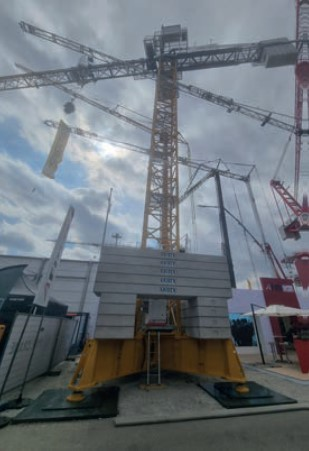
If a fibre rope is irreparably damaged at any point it can now be shortened and re-bonded on site.
As a result, Liebherr says, fibre rope is now more flexible to handle than its steel counterpart when it comes to rope damage.
In addition, the service life of fibre rope has been extended. As well as benefitting crane operation this has advantages in terms of warehousing times and storage logistics, Liebherr says.
ZOOMLION
Chinese manufacturer Zoomlion showcased its R800-40 flat-top at Bauma. It is Zoomlion’s largesttonnage model available in Europe and is aimed at bridge, powerplant and stadium projects.
It has a maximum load capacity of 40t and a jib length of 80m. The tip load is six tonnes and it can hoist up to 140m a minute.
The R800-40 is produced in China and assembled in Germany.
This, Zoomlion says, ensures rapid delivery times. The crane is backed by full-lifecycle servicing.
The crane is EN14439- compliant and can be spec’d with a range of safety systems and smart data controls. These include zoning and anti-collision systems, plus a hook video system.
The crane also offers anti-swing functionality, protection against sudden unloading, real-time monitoring of working conditions, dynamic deceleration, plus a ‘Zoom Plus’ function that boosts the load curve by ten percent.
The R800-40 uses all-pin connections to facilitate quick assembly/disassembly. The cab measures 2.5×1.5×2.2m and has air conditioning, heating and adjustable seats.
MANITOWOC
US manufacturer Manitowoc used Bauma to show its Potain MR 309 luffing jib crane to the world. The 16t capacity crane was announced in 2024 but has not been seen by a global audience until now.
The MR 309 comes in two variants, 16t or 25t, with a 60m jib, and a tip capacity of 3.4t. It has a 2m mast section and there’s up to 49.2m of free-standing height under pivot. The crane can lift 4.3t at 55m.
Manitowoc says the crane offers a reduced out-of-service radius (from 12 to 9.5m) and minimises anchorage frame requirements.
It comes with Potain’s Connect telematics system and CCS control system as standard.
The Potain MR 309 has a jib that can be mounted horizontally in either one or two parts to minimise space requirements during erection.
Platforms and steps are designed to enhance worker security and efficiency while the counter jib ballast is installed at working height, facilitated by built-in slinging points and a selfcentring system.
A redesigned luffing mechanism aims to streamline assembly, says Manitowoc, while an integrated jib-end basket enables more secure installation and maintenance.
At Bama Potain also announced its largest Potain luffing jib crane for the European and North American markets: the MR 819.
It has up to 70m of jib available and a maximum capacity of 64t – double that of the current largest Potain luffer (the 32t capacity MR 608B and MR 618).
The design of the MR 819 drew heavily on the design of the MR 309, resulting in an out-of-service radius of between 16 to 18m.
Using a dozen five-metre sections of Potain’s new 2.45m, K 880 mast system, the crane can be erected at a freestanding height of 65.6m with jib configurations up to 50m, or it can be configured at a 60.6m height, using 11 mast sections plus nine sections of jib.
When anchored to a building, it needs five anchoring frames to reach 210m with a 65m jib (for a C25 wind profile), says Manitowoc.
When rigged with three-fall reeving and a 55m jib, the MR 819’s 64t maximum capacity can be lifted out to 17m radius and up to 10.8t can be lifted at the jib end. With two-fall reeving and a 65m jib, it can lift 42t out to 21m and 7.4t at maximum radius.
Supporting these loads is a new hoisting winch: the 270 LVF 213 Optima. With 838m of rope, the high winding capacity of its 200kW motor can produce line speeds ranging from 183m/min in singlefall reeving to 61m/min in threefall reeving. The 110kW-rated 150 VVF 90 luffing hoist can raise the jib from 15° to 87° in 2min 20sec.
The cab is an Ultra View model with Manitowoc’s CCS control system and Potain Connect telematics platform.
SÁEZ
Spanish tower crane specialist Grúas Sáez showed its latest flat-top, the 50-tonne TLS 1100 flat-top (which is also available in 20- and 25-tonne versions). “We produced the 50-tonner in response to customer demand,” says Juan Ballester, sales manager at Saez. “At Sáez we want to offer the full spectrum of capacities.”
The 1,100-tonne-metre flat-top has an 86m boom and a hook height of up to 71.2m. At a radius of 86m it can lift almost 11t.
The crane has two trollies. With one trolley its capacity is 25t; this increases to 50t with both. It has a 110kW winch with a maximum speed of 114m per minute.
The TLS 1100 comes with Sáez’s latest Premium cab offering greater operator visibility, a separate room for the control electronics, and an elevated operator display screen for improved visibility.
The crane also utilises Sáez’s new tower sections, the HM line, which uses fewer (but larger) bolts for faster erection.
The model on display at Bauma, the very first one, had been bought by German crane rental and sales specialist BKL, with another four scheduled to follow.
Following Bauma the crane on returned to Spain for some final factory tests. It will then be sent back to Munich in June ready for its first job in the first week of July.
“We have been the first to buy this machine because, for us, it is perfect,” says Veronika Ledger, head of marketing at BKL. “We been using Sáez cranes in our rental fleet for the last eight or nine years now. This has demonstrated that they are great cranes. As such we became their sales dealer for Germany and Austria in March 2022. Our technicians really like Sáez cranes as they are easy to erect and good quality. That’s why, after renting in our fleet, we made the decision to sell them.”
BKL will use the crane to handle heavy loads in industrial and boiler and steel construction applications, plus to lift large prefabricated concrete parts and to install modular components.
“We’ve also had a lot of interest in this model,” Ballester adds. “We are also working on bigger luffing jib cranes. Our current largest is the SL830 with a 48t capacity but we are working on the SL1950 which will be a 150t luffer. It should be ready in about 12 months.”
JASO
At the lower end of the flat-top lifting capacity spectrum Spanish tower crane manufacturer Jaso used Bauma to expand its portfolio with the launch of the eight-tonne capacity J165.8 flat-top.
The manufacturer is well-known for its low-top crane designs but says customer demand has led it to focus on further developing its flat-top range.
The J165.8 uses Jaso’s Optimus Line technology to provide a lifting capacity of eight tonnes and, with a SR/DR trolley, a tip load of 1.76t at the jib’s maximum 60m radius. When in SR reeving mode this increases to 1.92t.
The jib starts at 30m and increases in five metre increments. The short counterjib means the crane’s swing radius with the full boom is just 12.8m.
Counterweight slabs are the ‘lay flat’ type. If required, the counterweight can be steel framed for enhanced safety.
A 33hp hoist comes as standard providing a maximum speed of 66m a minute. A 60hp unit, with a maximum speed of 180m/min, can be specified. Hoist drums can be spec’d with Lebus type grooving. Rope capacity is respectively 548 and 967m.
The crane uses use a standard 1.75×1.75m tower system. Its maximum free-standing height is 50.1m. Jaso is developing the crane to fit the 2.16 tower system for higher hook heights.
Three cross base options are available: 3.8×3.8m, 4.5×4.5m and 6x6m, for maximum hook heights of 42.8m, 54.7m, and 57.1m respectively.
The J165.8 comes with Jaso’s new Horizon cab, which was also launched at Bauma. It includes a diagnosis system and Jaso’s Smartlink cloud-based communication tool.
For easier assembly the heaviest component is the slewing platform with tower head (at six tonnes). They can be combed to reduce the number of transport units required. A full top kit can be transported in three lorries.
The crane comes with an ‘eco’ mode. In normal mode the crane runs on full power; switching to eco uses 75 per cent of the power, while ‘super eco’ mode works with 50% of the normal power consumption. It allows a crane with a bigger hoist motor to also work on less current. This helps on sites with restricted power supply.
‘Eco’ and ‘super eco’ modes reduce the hoist speed but only when hoisting up; when lowering the hook it’s the same speed as when working in normal mode.
The J165.8 joins the ten-tonne J200.10 and 12t J235.12. “These models cover the market between the city crane and the low top series,” says area manager Theodor Peter Huitema. “Applications include light weight construction with smaller precast concrete modules or for pouring concrete.
“Features include versatility for multiple applications, optimisation for component weight, plus quick and easy assembly in congested urban areas.
“A range of performance control characteristics are available: from micro speed and proportional slew movements to high operating speed and minimal power consumption.”
STAFFORD TOWER CRANES
Portugal-based Stafford Tower Cranes showed the first of its new luffing jib tower cranes: the STL257. It’s a 20t lifting capacity crane with a tip load of 3.05t and a 60m jib. It comes with a new cab design and an access lift as standard.
Stafford also offers a new STL757 – a 42t capacity luffer. “It’s so new we haven’t manufactured one yet but the designs are all set to go,” explains sales manager Patrick Stafford III. It has a 70m jib and a 5.8t tip load. “We also have a few smaller luffers in the pipeline,” Patrick Stafford III adds.
All Stafford’s cranes between four and 16t capacity have hydraulic dual operation (flat-top and luffing functions) as a unique design aspect.
All its cranes can be supplied with its ‘Smart-Link’ system, designed for safety and security.
“Reception to these cranes has been very good,” says Patrick Stafford III. “We’re focussing on the UK and Ireland markets to start, and then looking to expand to other countries in Europe, as well as in America where we see a growing demand for luffing jib cranes, plus Australia and New Zealand.”
MORITSCH CRANES
Italian tower crane manufacturer Moritsch Cranes utilised virtual reality to showcase its portfolio at Bauma, enabling visitors to experience what it’s like to operate its cranes from ground level.
Also at the show owner CEO Mariano Moritsch revealed plans to introduce multiple new models in 2025. Three new flat-top models are scheduled to join Moritsch’s RTM range: the RTM 90, RTM 150, and RTM 350 – providing a full portfolio from five to 16t.
In Moritsch’s luffing jib portfolio, it plans to add the 325 A1 – a 15t capacity single line pull crane with a 150kW hoist, followed by a 500tm, 18t capacity single line pull model: the RTL 505 A1.
Moritsch has already received a three-unit order for the 325 A1, and an order for the RTL 505 A1, from HCR Cranes in Australia.
Looking ahead Moritsch says it is aiming to produce 700 and 900tm luffing jib cranes by 2026.
COMANSA
Spanish company Comansa showed its new 6LC85 flat-top at Bauma 2025. It has a maximum capacity of five tonnes (in STA configuration) and a jib that extends in 2.5m increments from 20 to 52.5m.
According to Comansa the 6LC85 has been designed with simplified assembly and dismantling in mind. The jib can be erected either in one piece or section by section. It says assembly takes around six hours and the tower sections enable rapid, boltfree installation. In many cases assembly can be done directly from the truck, Comansa claims.
The crane’s modular design means many parts are interchangeable and compatible with other Comansa 6LC cranes.
The 6LC85 comes with the slewing and hoist mechanisms, the electrical control panel, and safety limiters, all integrated into a compact head design. This, it says, helps reduce installation times.
The compact design also aids with transportability. The crane, in standard configuration (and without a base), can be transported in three trailers.
Comansa also claims maintenance requirements are also reduced due to these key components being easily accessible in one place.
The 6LC85 has a new counterweigh system enabling installation of more than one block at once. The counterweights include lifting points for vertical or horizontal lifting.
A new aluminium trolley platform has bigger dimensions and improved safety guards than seen previously, plus it has a new ergonomic operator cabin with more space and improved visibility.
The cab is equipped with interior and exterior lighting, sun curtains, plus thermal and acoustic insulation and air conditioning.
A new control screen offers better visibility and functionality, says Comansa, enabling operators to have direct access to maintenance and service functions
FM GRU
Italian manufacturer FM Gru also had a stand at Bauma showcasing its topless FM 2065 TLX P10.
It has a 65m maximum jib length, a ten-tonne maximum load capacity (with double fall of rope), a tip load of two tonnes, and a 37.9Kw hoisting winch.
At Bauma it was installed at a height of 25m, a 46.5m jib, and a painted SK1700 tower section mounted on a 4.5 x 4.5m base.
The crane featured: radio remote control; a Deluxe cabin with air conditioning and heating; a black box and zoning system; plus, enhanced protection for the trolley and hoisting motors.
In conclusion, despite recent challenging business conditions the sheer number of tower crane innovations on display at Bauma highlights the resilience and innovation within the sector demonstrating that it remains strong, dynamic and full of opportunity.


